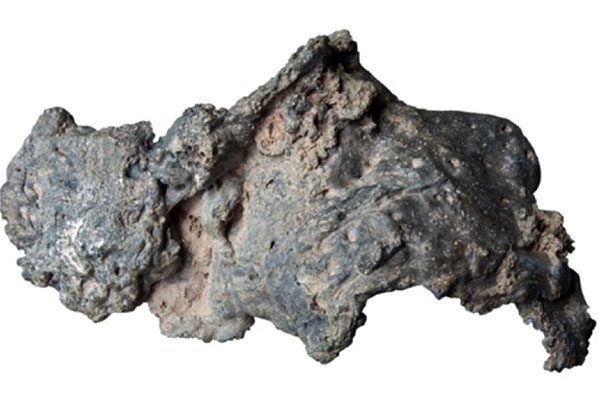
P. Schultz et al. / Geology 2021
A decade ago, researchers discovered huge chunks and slabs of dark green and black glass strewn across a 75 kilometer–long swath of the Atacama Desert in northern Chile. New evidence suggests they were created by an incoming fireball.
The glass pieces are uncannily similar to trinitite, the glassy mineral forged by the heat of the first atomic bomb test in the New Mexico desert in 1945. Carbon-14 dating of organic matter in soil directly beneath and in contact with the glass indicated that the chunks formed about 12,000 years ago, when the area was a grassy wetland dotted with trees.
Early investigators speculated that intense grassfires melted sandy soil to create the vast fields of glass. But new findings by a team led by Peter Schulz of Brown University disprove that explanation. Reporting November 2nd in Geology, the team instead suggests a far more violent — and cosmic — origin.
Schultz and his colleagues subjected 300 glass samples, collected at widely separated sites, to a comprehensive chemical analysis. They found that grains of the mineral zircon (zirconium silicate) embedded in the glass had been partially converted into baddeleyite, a rare form of essentially pure zirconium oxide. That transformation requires temperatures exceeding 1,670°C (3,040°F), much hotter than any grass fire.

Schultz et al. / Geology 2021
Volcanic eruptions can transport baddeleyite to the surface from the upper mantle, where it coats zircon particles in the diamond-bearing rock kimberlite. Yet there’s no evidence that volcanic activity created the Atacama Desert glass.
The glass is also riddled with inclusions of several “alien” minerals found in samples of Comet Wild 2, which NASA’s Stardust mission retrieved in 2006. Many of the slabs appear twisted and folded, as if subjected to tornado-force winds while molten.
To Schultz and his colleagues, the chemical signature of exceptionally high temperatures, the otherworldly composition of the entrained particles, the contorted forms of many glass shards, and the absence of an impact crater are compelling evidence that a cosmic intruder exploded over South America at an altitude of less than a mile. The fireball’s intense radiant heat fused the underlying soil into molten glass; a series of blast waves then sheared and tossed the glass about before it solidified.

P. Schultz et al. / Geology 2021
The elongated shape of the glass field may be the result of a single cometary body with a grazing trajectory or a cluster of comet fragments that entered the atmosphere at a higher angle, like the collision of tidally disrupted Shoemaker-Levy 9 with Jupiter in 1994. According to Schultz, the energy of the airburst over Chile dwarfed the 12-megaton Tunguska Event that felled 80 million trees in a remote Siberian wilderness in 1908.
The age of the Atacama Desert glass coincides with the re-advance of glaciers in the Andes and the sudden disappearance of more than 80% of the large mammals in South America. Schultz doesn’t claim a direct causal link to these climate and extinction events, but he does find the timing intriguing.
